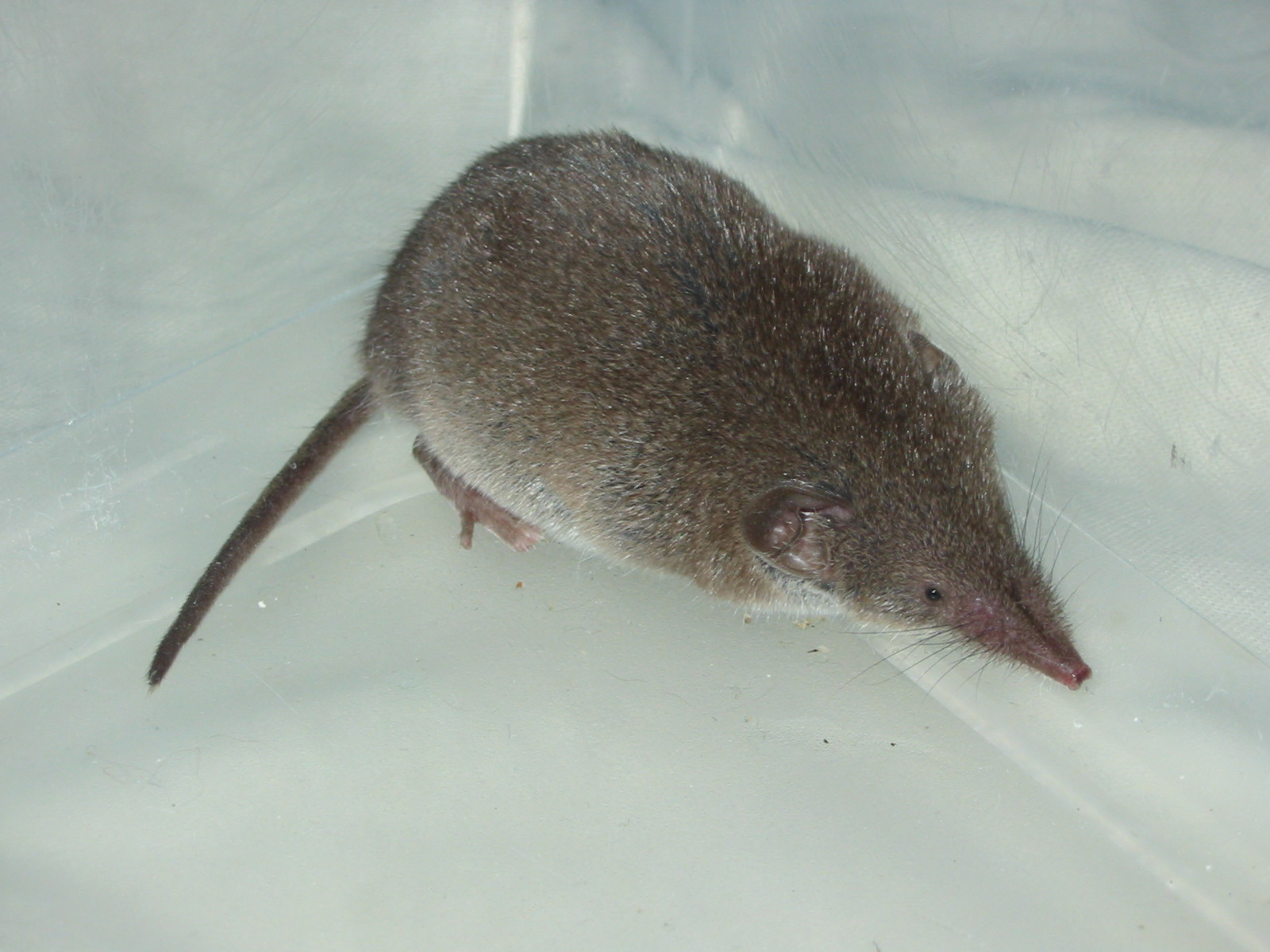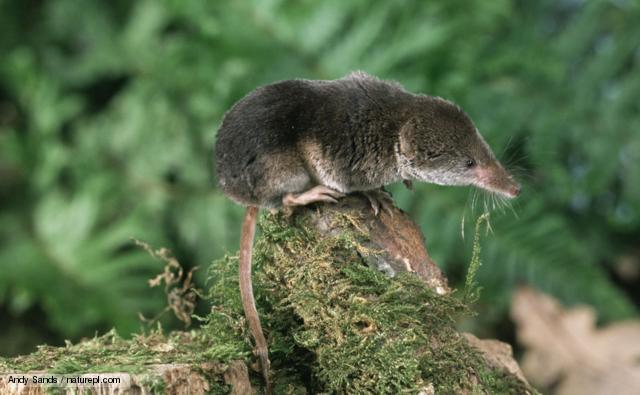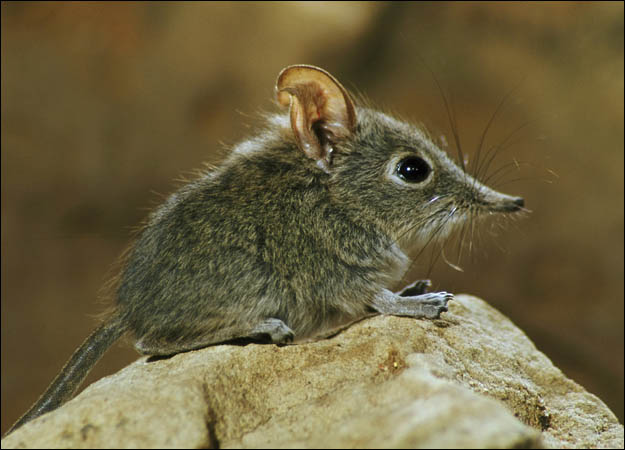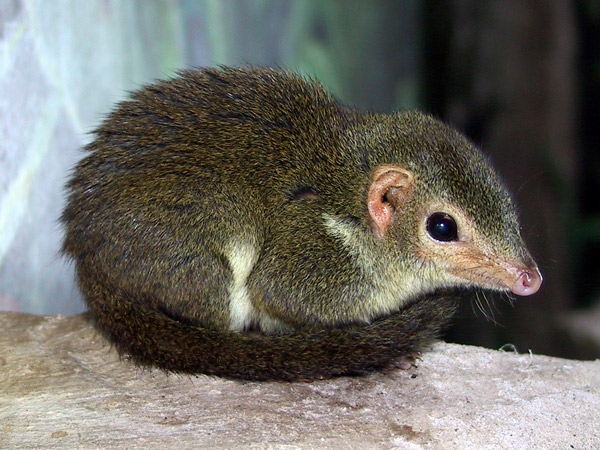
Shrews are usually very small; the Savi'spygmy
shrew is probably the smallest known mammal
on earth, less than 1.5 inches long and weighing
0.07 ounces. The shrewfamily, Soricidae, is the
largest family of the order Insectivora, and shrews
inhabit all major land masses except polar regions,
Australia, New Zealand, and Greenland.
Shrews are useful to gardeners because they eat
many insects. They also inhabit fields, marshes,
and woodlands. Some shrews are semiaquatic.
Shrews are often mistaken for mice because of
their small size and vaguely similar bodies. Their
habits and bodies are actually more like those of
moles. Shrews have long, mobile snouts, tiny ears
and eyes, and bodies covered with short, thick
hair colored gray, brown, or black. Smaller shrews
are under two inches long, while the largest are
one foot long. They eat insects, worms, small fish,
and plants. Weasels, foxes and owls eat shrews.
However, the shrew's unpleasant odor and taste
protects it from excessive predation.
Physical Characteristics of Shrews
Shrews have sharp teeth and are both vicious and
ferocious. When attacked or disturbed, they fight
wildly. They live alone, stake out territories, and
hold them against invaders. As added protection,
some shrews have venomous saliva, which they
use to poison prey. Shrews also have whiskers that
aid detection of prey at night. Shrews live in gardens,
forests, woodlands, and grasslands. Most
dig burrows, though some species do not burrow
and others are semiaquatic.
The largest shrew is an elephant shrew, also
called the golden-rumped shrew. These "giant"
shrews have maximum body lengths of one foot,
tails ten inches long, and weigh one pound. Elephant
shrews are so named for their long snouts.
Their tails are like rat tails and their hind legs are
designed for hopping.Asmall elephant shrew, the
short-eared shrew, has maximum body length of
four inches, a tail of five inches, and a weight of 1.5
ounces. Elephant shrews inhabit South Africa and
eat insects, snails, and plant roots, fruits, and seeds.
Shrews forage day and night and must eat every
two to three hours to survive. This great need
for food leads shrews to eat anything available.
Depending on habitat and species, they eat insects,
worms, carrion, seeds, nuts, plants, shellfish,
frogs, and fish. Shrews hear and smell well.
This helps them find prey and avoid predators.
Some creatures kill shrews, but most will not eat
them because they smell and taste bad. The smell
and taste is due to secretions from skin glands
most plentiful at knee and elbow.
The Life Cycles of Shrews
Shrews live alone except when mating. This occurs
year round, except in cold climates, where
mating is from March to September. Gestation,
two to three weeks, takes places in nests that females
dig. A female can have ten litters a year.
Each litter contains three to ten furless, blind young.
An exception to standard litter size occurs in elephant
shrews,whohave one or two offspring. Offspring
are full grown four weeks after birth.
Because of long mating seasons, some mothers
nurse a litter while pregnant. Young leave nests
after two to three weeks. Females mature in 1.5
months and males in 3 months. Courtship is short
since shrews fight, even with mates. The life spans
of shrews range fromone to five years, depending
on species.
The American Short-Tailed Shrew
American short-tailed shrews inhabit southeastern
Canada, the northeastern United States,
Texas, and Louisiana. They have thick, gray-black
fur, are four to five inches long, have one-inch
tails, and weigh one ounce. Like other shrews,
American short-tailed shrews constantly seek
food, eating insects, earthworms, snails, small
vertebrates, centipedes, spiders, mice, frogs, and
plants. They have venomous saliva, used to stun
and kill prey, which is also painful to humans and
large animal predators. Predators of the shrews
are owls and other raptors.
American short-tailed shrews live alone except
when mating, which happens from late winter to
the next September. Courtship is short because
shrews are harsh, even to mates. Females give
birth after two to three weeks to litters of four to
nine young. Young leave after a month. As with
other shrew species, males are mature in 1.5
months, females in three. The life span of these
shrews is two to three years.
Most shrews are harmless to humans, though
bites of some species cause severe pain. They are
useful in gardens and farms, where their consumption
of insects and grubs cuts down harmful
insect populations. Shrews are also useful ecologically
because they eat carrion, preventing its decay
and resultant endangerment of humans and
other animals.
Shrew Facts
Classification:
Kingdom: Animalia
Subkingdom: Bilateria
Phylum: Chordata
Subphylum: Vertebrata
Class: Mammalia
Order: Insectivora
Family: Soricidae (shrews), with twenty-two genera
and 246 species
Geographical location: Worldwide except for
poles, Australia, New Zealand, and Greenland
Habitat: Most in gardens, fields, marshes, and
woodlands; some are semiaquatic and spend
much time in freshwater
Gestational period: Thirteen to twenty-four days
Life span: One to five years in the wild
Special anatomy: Mobile snout, venomous saliva,
glands that make offensive excretions to
dissuade predators
Other popular Animals
Photo Gallery of - Shrew








 Animalia Life
Animalia Life